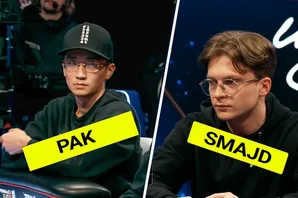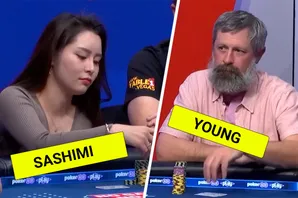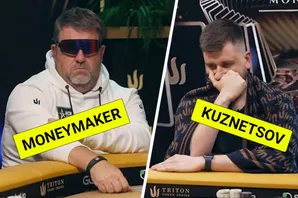Andrew ‘LuckyChewy’ Lichtenberger is considered one of the best high-stakes MTT pros in the game, with career earnings of more than $20,000,000. In an ongoing series for PokerOrg, he outlines his approach to some of the mental aspects of poker.
Advanced vs beginner player GTO tools
The game theory tools that an advanced player would use to derive their strategies are the same tools that a novice would use. The difference is that the professional looks at them under a microscope, while the novice takes a bird's eye view.
Game theory is broken down into a few different categories; we have different subsets within those categories. Essentially, these subsets are the building blocks from which we create our strategic approach to poker.
I like to think of poker strategy as a slew of competing factors with multiple ideas or concepts weighing you towards a decision. And it's not always the case that they all lean you in the same direction to clarify what you should do in one situation or another. This is what makes poker so exciting - so many factors and possible outcomes to consider!
Position, stacks, ranges and strategy
Since the game starts pre-flop, it makes sense to begin from there. The first thing to consider is your position at the table. Understanding that from early positions, you will want to play fewer hands because more players are left to act, helps you avoid playing hands with limited upside, or EV(expected value). You can open up more from the middle position, and then play the most hands from the late positions.
After considering position, the idea of stack depth and SPR (stack-to-pot ratio) are next. This is because ante and blind structures are not always constant throughout all poker formats. SPR helps us understand the possibility or likelihood of getting all-in, which is always looming in a game like no-limit hold'em and driving many of our choices. SPR thresholds and inflection points drive many of our strategic choices with our range.
The construction of hand ranges is integral to poker. Our range and that of our opponents are always the main questions to call into consideration in problem solving. The estimation of range vs range interactions and the analysis therein is what allows us to begin to understand how equity and EV are drivers in decision making (more to come on that shortly).
Range analysis starts preflop and is some of the lowest hanging fruit in poker. By playing too many hands, you will often get burnt on later streets where your range is too wide. This is where I recommend using the tools at Octopi Poker in order to study away from the table.
Strategy as the fourth and final of these building blocks is the synthesis of the previous three. Together, we can begin to create frameworks which we use to problem solve. Intuition can be layered on top of this to assist, as well.

Range analysis and strategy
Understanding that positions and stack depths create ranges is the first part of understanding how to properly evaluate ranges. The next step is to also understand that ranges and strategy have somewhat of an interchangeable nature to one another. In order to generate a range, you need a strategy, and in order to generate a strategy, you need a range.
So... what now? How does this work? Well, in order to model a range for a pre-flop scenario we need to know positions, stack sizes, any relevant payout information, and what strategic options are being considered.
Once that information is input, out comes a pre-flop range. From there, that pre-flop range can be used to begin deducing how it will continue to shrink and split based on various post-flop action sequences.
The most important part of understanding ranges and building strategies therein is to focus on the different subsets of your range, particularly your value region. Your value region drives your ability to play aggressively. Bluffs follow value, not the other way around; the strategies you use should always consider this first and foremost.
Your ideal strategy is to keep all your ranges balanced to the best of your abilities. Different parts of your ranges support one another for different reasons. So, for example, you may have a scenario where a weak top pair is better served to be put into your checking range, where it will reign towards the top end of that range - as opposed to being put in your value (betting) range where it will rest somewhere in the middle. This idea leads to capped vs uncapped ranges and the exploitative approaches players can take to strategically undermine poor range construction.

What is equity?
Let’s now explore the topic of equity. Equity can be viewed in three ways. The first is hand vs hand, the second is hand vs range, and the third is range vs range. We need to consider range vs range equity analysis and have foresight about what could happen on future streets in order to best inform us of what strategy makes the most sense to play.
Within the concept of equity, we have two opposing forces - Equity Realization and Equity Denial. Essentially, if you assume that every player is dealt roughly the same amount of good and bad hands over a long enough timeline, the player who wins the most is going to get paid more when they have good hands and win more often without showdown when they don't.
The question is, how do you accomplish that? It’s fairly straightforward: you must know how your good hands want to play. And in tandem with that, because they're inseparable, know how your bluffs also want to play.
If this overall framework we’ve been discussing can be understood and digested, it's all you need to begin to improve on poker strategies and tactics. From there, you can overlay any additional theoretical approaches because you’ve established a solid foundation with which to begin.
Next: Going to Valuetown
Andrew Lichtenberger is a co-founder of the poker community and training site Octopi Poker, with Nick Schulman and Victoria Livschitz. Octopi Poker uses GTO tools, drills, coaching, and streamed hand histories for an all-in-one integrated platform for collaborative poker study. Follow Andrew on Twitter/X.

































